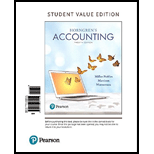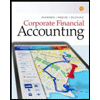
Concept explainers
Comparing ending merchandise inventory, cost of goods sold, and gross profit using the periodic inventory system-FIFO, LIFO, and weighted-average methods.
Learning Objective 7 Appendix 6A
2: COGS $513
Assume that Jump Coffee Stop completed the following period, inventory transactions for a lie of merchandise inventory:
Jun. 1 Beginning merchandise inventory 17 units @ $ 15 each
12 Purchase 5 units @ $ 19 each
20 Sale l4 units @ $ 37each
24 Purchase 11 units @ $ 23 each
29 Sale l3 units @ $ 37each
Requirements
1. Compute ending merchandise inventory, cost of goods sold and gross profit using the FIFO inventory costing method.
2. Compute ending merchandise inventory, cost of goods sold and gross profit using the LIFO inventory costing method.
3. Compute ending merchandise inventory, cost of goods sold and gross profit using the weighted-average inventory costing method. (Round weighted −average cost per unit to the nearest cent and all other amount to the nearest dollar.)
Want to see the full answer?
Check out a sample textbook solution
Chapter 6 Solutions
Horngren's Accounting, Student Value Edition Plus MyLab Accounting with Pearson eText -- Access Card Package (12th Edition)
 Corporate Financial AccountingAccountingISBN:9781305653535Author:Carl Warren, James M. Reeve, Jonathan DuchacPublisher:Cengage Learning
Corporate Financial AccountingAccountingISBN:9781305653535Author:Carl Warren, James M. Reeve, Jonathan DuchacPublisher:Cengage Learning Financial & Managerial AccountingAccountingISBN:9781285866307Author:Carl Warren, James M. Reeve, Jonathan DuchacPublisher:Cengage Learning
Financial & Managerial AccountingAccountingISBN:9781285866307Author:Carl Warren, James M. Reeve, Jonathan DuchacPublisher:Cengage Learning Cornerstones of Financial AccountingAccountingISBN:9781337690881Author:Jay Rich, Jeff JonesPublisher:Cengage Learning
Cornerstones of Financial AccountingAccountingISBN:9781337690881Author:Jay Rich, Jeff JonesPublisher:Cengage Learning AccountingAccountingISBN:9781337272094Author:WARREN, Carl S., Reeve, James M., Duchac, Jonathan E.Publisher:Cengage Learning,
AccountingAccountingISBN:9781337272094Author:WARREN, Carl S., Reeve, James M., Duchac, Jonathan E.Publisher:Cengage Learning, Financial And Managerial AccountingAccountingISBN:9781337902663Author:WARREN, Carl S.Publisher:Cengage Learning,
Financial And Managerial AccountingAccountingISBN:9781337902663Author:WARREN, Carl S.Publisher:Cengage Learning,





